
Saint Julian's is a town in the Eastern Region of Malta. As of 2020, its registered number of inhabitants stands at 13,792. It is situated along the coast, north of the country's capital, Valletta. It is known for tourism-oriented businesses, such as hotels, restaurants and nightclubs which are centred mainly in an area known as Paceville.
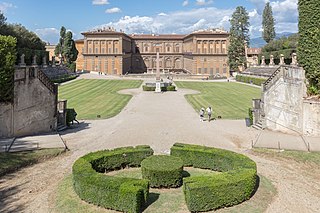
The Boboli Gardens is a historical park of the city of Florence that was opened to the public in 1766. Originally designed for the Medici, it represents one of the first and most important examples of the Italian garden, which later served as inspiration for many European courts. Statues of various styles and periods, ancient and Renaissance, dot the garden. It also has large fountains and artificial caves, notably a grotto built by the artist, architect, and sculptor Bernardo Buontalenti between 1536 and 1608.
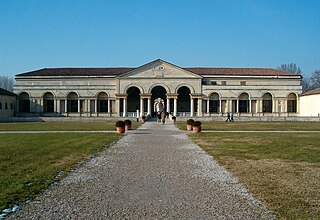
Palazzo del Te, or simply Palazzo Te, is a palace in the suburbs of Mantua, Italy. It is an example of the mannerist style of architecture, and the acknowledged masterpiece of Giulio Romano.

The Villa Farnese, also known as Villa Caprarola, is a pentagonal mansion in the town of Caprarola in the province of Viterbo, Northern Lazio, Italy, approximately 50 kilometres (31 mi) north-west of Rome, originally commissioned and owned by the House of Farnese. A property of the Republic of Italy, Villa Farnese is run by the Polo Museale del Lazio. This villa is not to be confused with two similarly-named properties of the family, the Palazzo Farnese and the Villa Farnesina, both in Rome.

António Manoel de Vilhena was a Portuguese nobleman who was the 66th Prince and Grand Master of the Order of St. John of Jerusalem from 19 June 1722 to his death in 1736. Unlike a number of the other Grand Masters, he was benevolent and popular with the Maltese people. Vilhena is mostly remembered for the founding of Floriana, the construction of Fort Manoel and the Manoel Theatre, and the renovation of the city of Mdina.

Paceville is a district in St Julian's which is the main nightlife hub in Malta, being heavily populated with nightclubs, bars, strip clubs, pubs and restaurants. It is hence also known as 'Malta's Sin City'. Paceville is located between Spinola Point and Dragonara Point, delimiting Spinola Bay and St. George's Bay respectively.

The Grandmaster's Palace, officially known as The Palace, is a palace in Valletta, Malta. It was built between the 16th and 18th centuries as the palace of the Grand Master of the Order of St. John, who ruled Malta from 1530 to 1798, and was also known as the Magisterial Palace. When the knights were expelled by Napoleonic France, it became the National Palace. During the period of British rule beginning in 1800, it was the Governor's Palace.
This page list topics related to Malta.
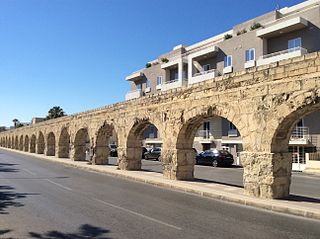
The Wignacourt Aqueduct is a 17th-century aqueduct in Malta, which was built by the Order of Saint John to carry water from springs in Dingli and Rabat to the newly built capital city Valletta. The aqueduct carried water through underground pipes and over arched viaducts across depressions in the ground.

Palazzo Pescatore is a palace in St. Paul's Bay, Malta. It was built in the late 19th century. Its symmetrical porticoed façades of neo-classical inspiration are similar to those of Palazzo Dragonara in St. Julian's.

Villa Francia, initially named Palazzo Francia, then named Villa Preziosi, and officially known as Palazzo Francia and Francia Estate, is an 18th-century palace in Lija, Malta. The palace was built circa 1757, by Francesco Preziosi, with baroque architecture that gave a sense of pride and power to noble people at the time. The first ambitious owner became bankrupt with the expenses of the palace, to make it an outstanding and incomparable building, and because of this he was pressured to sell his possession by the Order of St. John to pay his accumulated debts.

Palazzo Correa, also known as Casa Correa, Correa de Sousa Palace or Palazzo Hompesch, was a 17th-century palace in Valletta, Malta, located in Old Bakery Street. It was built on the designs to architect Carlo Gimach in the Mannerist style, the first in Valletta and very unusual to the period.
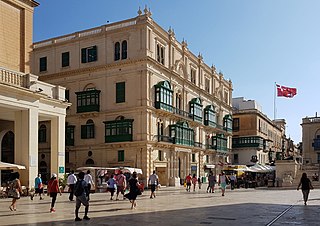
Palazzo Ferreria, officially Palazzo Buttiġieġ-Francia, is a palace found near the entrance of Valletta, the capital city of Malta. It was built in the late 19th century. Designed by Architect Giuseppe Bonavia, it makes use of an interesting concept of adding local timber balconies to a design inspired from that of buildings in Italy. It is protected as a Grade 2 national monument.

Palazzo Parisio, sometimes known as Casa Parisio, is a palace in Valletta, Malta. It was built in the 1740s by Domenico Sceberras, and eventually passed into the hands of the Muscati and Parisio Muscati families. It was Napoleon's residence for six days in June 1798, during the early days of the French occupation of Malta. The palace was eventually acquired by the de Piro family, and was later purchased by the Government of Malta. It was used as the General Post Office from 1886 to 1973, then the Ministry for Agriculture, and it now houses the Ministry for Foreign Affairs.

Palazzo Parisio, formerly known as Scicluna Palace, Palazzo Scicluna, and officially Palazzo Parisio and Gardens, is a 20th-century palace in Naxxar, Malta. On site was a hunting lodge built in 1733 by Paolo Parisio, and was used as a summer or permanent residence, barracks and a college, before being acquired by the Marquis Scicluna in 1898.
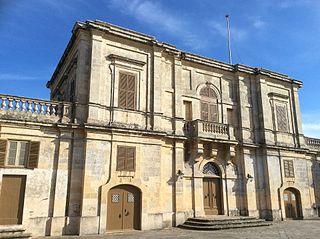
Palazzo Dorell, also known as Bettina Palace, is a 17th-century Palladian palace located in Gudja, Malta.

Palazzo Nasciaro is an 18th-century townhouse in Naxxar, Malta, built during the Order of St. John. The townhouse was originally built as a family home, but has undergone adaptive reuse several times to fit the changing needs of the local population.

Palazzo Santa Sofia is a palace in Mdina, Malta, located in Villegaignon Street, across the square from the cathedral. Its ground floor was built in 1233, and it is believed to be the oldest surviving building in the city. The upper floor is of a much later construction, being built in the 20th century.
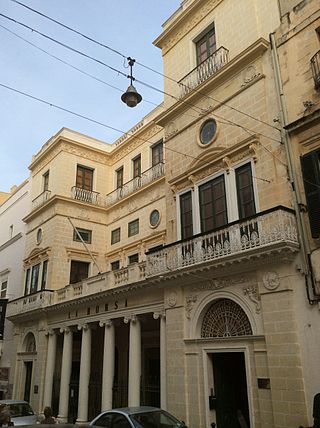
Giuseppe Bonavia was a Maltese draughtsman and architect who was mainly active in the second half of the 19th century. Born in Valletta, he was initially a clerk of works with the Royal Engineers, before becoming the Head of the Civil Service Works Department.

Ædes Danielis, sometimes known as Palazzo Gregorio Bonici, is a late 17th century renaissance building with a private garden in Żejtun, Malta. It is a historic private property built by Gregorio Bonici as his secondary residence, and is now owned by the descendants of the Bonici and Testaferrata families.

























